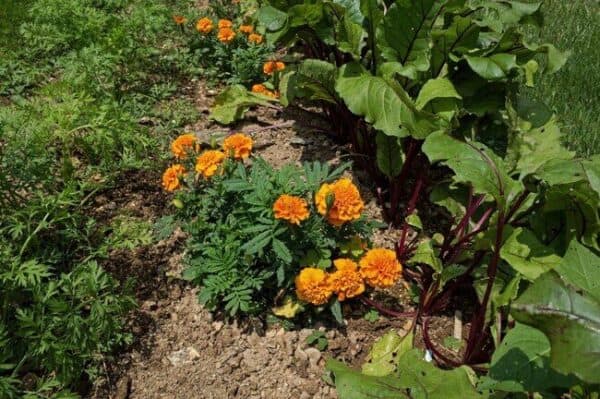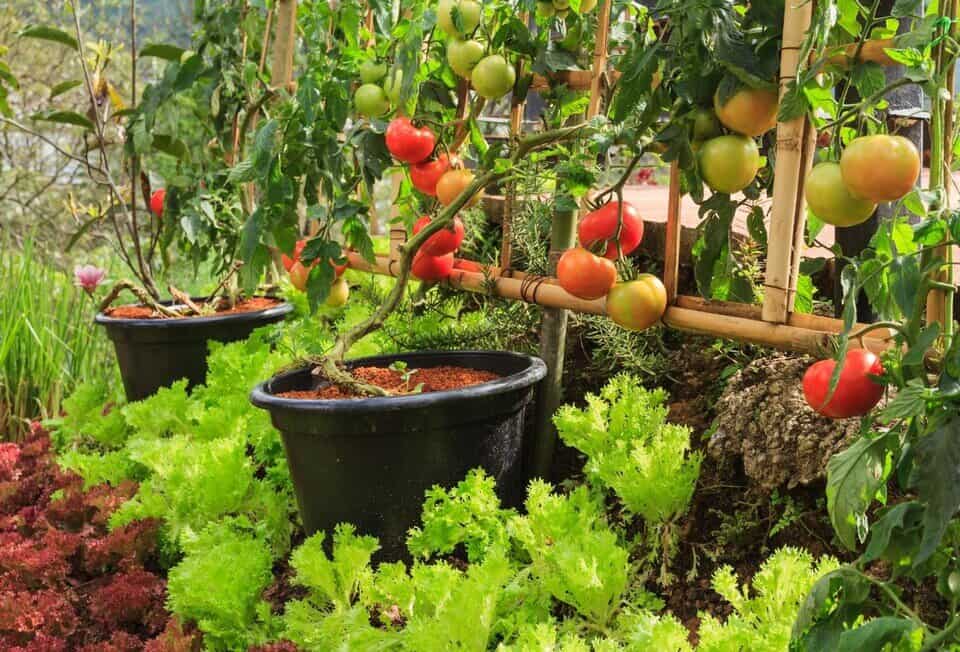Companion planting is the practice of growing different plants together in a way that benefits each other. This technique has been used for centuries and is gaining popularity among gardeners as a natural and sustainable way to improve crop yields and reduce pest problems. The basic idea behind companion planting is that certain plants have natural affinities for each other and when grown together, they can help each other thrive.
Companion gardening: A gardening practice where mutually beneficial plants are grown together to improve yield, pest control, and overall garden health. Common examples include planting tomatoes with basil or beans with corn.
There are many benefits to companion planting. For example, some plants can help repel pests or attract beneficial insects that prey on pests. Others can improve soil fertility by fixing nitrogen or breaking up hard soil. Companion planting can also help maximize space in the garden by growing plants vertically or by intercropping, where two or more crops are grown together in the same space.
While companion planting is not a guarantee for a successful garden, it can be a useful tool for any gardener looking to improve their yields and reduce pest problems in a natural and sustainable way. By understanding the natural affinities between plants and how they can benefit each other, gardeners can create a healthy and thriving ecosystem in their own backyard.
Understanding Companion Planting: The Basics
Companion planting is the practice of growing two or more plants together for mutual benefit. This technique has been used for centuries to increase crop yields, repel pests, and improve soil health. The idea behind companion planting is that certain plants can help each other grow better when planted together, while others can hinder each other’s growth.
There are several ways in which companion planting can be beneficial. Firstly, some plants can help repel pests that would otherwise damage crops. For example, marigolds are known to repel nematodes, while garlic can deter aphids and other insects. Secondly, companion planting can help improve soil health by fixing nitrogen in the soil. Legumes such as peas and beans are particularly good for this. Thirdly, certain plants can attract beneficial insects such as bees and ladybugs, which can help pollinate plants and control pests.
When planning a companion planting scheme, it is important to consider which plants will grow well together and which will not. Some plants, such as tomatoes and basil, are known to be good companions, while others, such as tomatoes and potatoes, should be kept apart. There are also plants that are known to be allelopathic, meaning that they release chemicals into the soil that can inhibit the growth of other plants. For example, black walnut trees are known to be allelopathic, and should be avoided when planning a companion planting scheme.
Another important consideration when planning a companion planting scheme is the timing of planting. Some plants, such as peas and beans, are best planted in the early spring, while others, such as tomatoes and peppers, are best planted in the late spring or early summer. By carefully planning the timing of planting, it is possible to ensure that plants grow well together and provide mutual benefits.
Top Companion Plant Pairs for a Thriving Garden
Companion planting is a gardening technique that involves planting different crops together to enhance growth and protect against pests and diseases. Here are some of the top companion plant pairs that can help you achieve a thriving garden.
Tomatoes and Basil
Tomatoes and basil are a classic companion plant pair. Basil repels harmful insects that can damage tomato plants, while also attracting pollinators that help with tomato production. Additionally, basil can improve the flavor of tomatoes when planted nearby.
Corn, Beans, and Squash
Corn, beans, and squash are known as the “three sisters” in companion planting. These three plants complement each other’s growth and nutrient needs. Corn provides a natural trellis for beans to climb, while beans fix nitrogen in the soil that benefits corn and squash. Squash, in turn, provides ground cover that helps retain moisture and suppress weeds.
Carrots and Onions
Carrots and onions make great companions in the garden. Onions repel carrot flies, which can damage carrot roots, while carrots attract beneficial insects that help control onion pests. Additionally, onions can improve the flavor of carrots when planted nearby.
Lettuce and Radishes
Lettuce and radishes are a quick-growing companion plant pair. Radishes grow quickly and can be harvested before lettuce needs the space, making them a great intercrop. Additionally, the peppery taste of radishes can deter pests that might otherwise be attracted to lettuce.
By planting these top companion plant pairs in your garden, you can help promote healthy growth and protect against pests and diseases. Experiment with different combinations to find what works best for your garden.
How Companion Planting Enhances Yield & Pest Control
Companion planting is an ancient agricultural technique that involves planting two or more plant species in close proximity to one another for mutual benefit. Companion planting can help enhance crop yield and control pests in various ways.

Firstly, companion planting can help improve soil quality. Certain plants are known to have deep roots that can break up compacted soil and draw up nutrients from deep in the ground. These nutrients can then be made available to other plants in the vicinity, resulting in healthier plants and higher yields.
Companion planting can also help control pests and diseases. For example, planting marigolds alongside tomato plants can help repel nematodes, a type of microscopic worm that can damage tomato roots. Similarly, planting basil near tomato plants can help repel tomato hornworms, a common pest that can defoliate tomato plants.
Another way companion planting can enhance yield is by attracting pollinators. Some plants, such as sunflowers and lavender, are known to attract bees and other pollinators, which can help increase fruit and seed production in nearby plants.
Finally, companion planting can help create a more diverse and resilient ecosystem in the garden. By planting a variety of plant species, gardeners can help support a wide range of beneficial insects and microorganisms, which can help control pests and diseases naturally.
Implementing Companion Planting in Your Garden Layout
Companion planting is a technique that involves planting different crops together to improve their growth and health. Here are some tips for implementing companion planting in your garden layout:
- Choose plants that have complementary growing habits. For example, tall plants can provide shade for shorter plants, while plants with deep roots can help break up soil for shallow-rooted plants.
- Consider the nutrient needs of each plant. Some plants, such as legumes, can fix nitrogen in the soil, while others may deplete certain nutrients. Planting crops with different nutrient needs can help ensure that the soil remains balanced.
- Use plants that have natural pest-repellent properties. For example, planting marigolds alongside vegetables can help deter pests such as nematodes.
- Rotate crops each season to prevent soil-borne diseases and pests from building up in the soil.
- Consider the timing of planting. Some plants, such as cool-season crops, can be planted alongside warm-season crops to help maximize space and yield.
When planning your garden layout, it’s important to keep in mind the specific needs of each plant and how they can complement each other. By implementing companion planting techniques, you can create a more diverse and sustainable garden that is better equipped to resist pests and disease, while also improving soil health and maximizing yield.
Companion Planting Tips for Small Spaces & Urban Gardens
Companion planting can be a great way to maximize the yield and health of your plants, even in small spaces and urban gardens. Here are a few tips to help you get started:
- Choose plants that have complementary needs and growth habits. For example, plant tall, sun-loving plants like tomatoes and peppers alongside shorter, shade-tolerant plants like lettuce and spinach.
- Consider using containers or raised beds to make the most of limited space. This can also help you control soil quality and drainage.
- Plant herbs and flowers alongside your vegetables to attract beneficial insects and deter pests. For example, marigolds can help repel nematodes, while basil can help repel aphids.
- Rotate your crops each year to prevent soil-borne diseases and pests from building up over time. This can be especially important in small spaces where you may not have as much room to spread out your plants.
- Consider using trellises or other vertical structures to help your plants grow up instead of out. This can be a great way to save space and make the most of limited square footage.
By following these tips, even gardeners with limited space can enjoy the benefits of companion planting. With a little planning and creativity, you can create a thriving garden that provides fresh, healthy produce all season long.
Boosting Soil Health with Companion Planting
Companion planting is a practice of planting different crops together to enhance their growth and productivity. But did you know that it can also help boost the health of your soil? By strategically planting different crops together, you can create a diverse and healthy ecosystem in your garden that benefits both the plants and the soil.

One of the ways companion planting can improve soil health is by increasing the amount of organic matter in the soil. Plants like legumes, which have nitrogen-fixing bacteria in their roots, can help add nitrogen to the soil, which is an essential nutrient for plant growth. Other plants, like cover crops and green manure, can help improve soil structure and prevent erosion.
Companion planting can also help reduce soil-borne diseases and pests. For example, planting marigolds alongside tomatoes can help repel nematodes, while planting garlic and onions can help repel aphids and other insects. By planting a variety of crops together, you can create a natural balance that reduces the need for chemical pesticides and fertilizers.
Another benefit of companion planting is that it can help attract beneficial insects and pollinators to your garden. Plants like sunflowers, daisies, and lavender can attract bees and other pollinators, while plants like dill and fennel can attract beneficial insects like ladybugs and lacewings.
Overall, companion planting is a simple and effective way to boost the health of your soil and create a thriving garden ecosystem. By planting a variety of crops together and taking advantage of the natural benefits of different plants, you can create a garden that is both productive and sustainable.
Attracting Beneficial Insects through Companion Planting
Companion planting is a natural and effective way to attract beneficial insects to your garden. Beneficial insects are those that help control pests and pollinate plants, making them an essential part of any healthy garden ecosystem. By planting certain types of plants next to each other, you can create a habitat that attracts and supports these helpful creatures.
One of the most effective ways to attract beneficial insects is by planting flowers. Flowers not only add color and beauty to your garden, but they also attract a wide variety of beneficial insects, including bees, butterflies, and ladybugs. Bees are particularly important, as they are essential for pollinating many of the fruits and vegetables that we eat.
Some of the best flowers for attracting beneficial insects include marigolds, sunflowers, zinnias, and alyssum. These plants are easy to grow and will attract a wide variety of insects to your garden. In addition to flowers, certain herbs can also be effective at attracting beneficial insects. Herbs like dill, fennel, and parsley are particularly attractive to ladybugs and other beneficial insects.
Another way to attract beneficial insects is by planting a variety of plants in your garden. By planting a diverse range of plants, you can create a habitat that attracts a wide variety of insects. For example, planting a mix of vegetables, herbs, and flowers can help attract a range of beneficial insects to your garden.
Finally, it’s important to avoid using pesticides and other chemicals in your garden. Pesticides can be harmful to both beneficial insects and the environment, and can disrupt the delicate balance of your garden ecosystem. By using natural methods like companion planting, you can create a healthy and thriving garden that supports a wide range of beneficial insects.
Avoiding Common Companion Planting Mistakes
Companion planting can be a great way to improve the health and yield of your garden. However, there are some common mistakes that many gardeners make when attempting to use this technique. Here are a few tips to help you avoid these mistakes:
1. Planting incompatible plants together
One of the most common mistakes in companion planting is planting incompatible plants together. Some plants simply do not grow well together and can actually harm each other. For example, planting beans and onions together can stunt the growth of both plants. Before planting, do some research on which plants are compatible with each other and which ones should be kept separate.
2. Planting too close together
Another mistake is planting companion plants too close together. While it may seem like a good idea to pack as many plants as possible into a small space, overcrowding can actually lead to a decrease in yield and an increase in disease. Make sure to give each plant enough space to grow and thrive.
3. Ignoring the needs of individual plants
While companion planting can be beneficial, it’s important to remember that each plant has its own individual needs. For example, some plants require more water than others, while some need more sunlight. Make sure to take these individual needs into account when planning your garden.
4. Not rotating crops
Finally, not rotating crops can lead to a decrease in yield and an increase in disease. When plants are grown in the same spot year after year, they can deplete the soil of certain nutrients and make it more susceptible to disease. Make sure to rotate your crops each year to keep your soil healthy.
By avoiding these common mistakes, you can make the most of companion planting and enjoy a healthy and bountiful garden.
Success Stories: Companion Planting in Action
Companion planting has been used for centuries to improve crop yields, reduce pest problems, and enhance the overall health of a garden. Here are a few success stories of companion planting in action:
Tomatoes and Basil: Planting basil near tomatoes has been shown to improve the flavor of the tomatoes and deter pests such as tomato hornworms. The basil also attracts beneficial insects such as bees and butterflies, which help pollinate the tomatoes.

Carrots and Onions: Planting carrots and onions together can help repel carrot flies and onion maggots. The strong scent of the onions masks the smell of the carrots, making it harder for pests to find them.
Corn, Beans, and Squash: Known as the “Three Sisters,” planting these three crops together in a traditional Native American method has been shown to improve soil health and crop yields. The corn provides a trellis for the beans to climb, while the beans fix nitrogen in the soil for the corn and squash. The large leaves of the squash provide shade and help retain moisture in the soil.
Marigolds and Everything: Marigolds are known for their ability to repel pests such as nematodes, whiteflies, and beetles. Planting marigolds throughout the garden can help protect all of the plants from these pests.
These are just a few examples of the many successful companion planting combinations. By experimenting with different plant combinations, gardeners can discover what works best for their unique growing conditions and preferences.
Expanding Your Garden: Experimenting with New Companion Plant Combinations
After successfully implementing companion planting in your garden, you may want to try experimenting with new combinations of plants to see what works best for you. Here are a few tips to help you get started:
- Research: Before trying out new combinations, do some research on the plants you are considering. Make sure they have similar growing conditions and will not compete for resources.
- Start small: Start with just a few plants of each variety to see how they work together. This will allow you to make adjustments as needed without risking your entire garden.
- Keep records: Keep track of which combinations work well and which do not. This will help you make informed decisions in the future.
- Be open to change: Don’t be afraid to try new combinations or make adjustments to existing ones. Gardening is all about learning and adapting.
Here are a few new combinations to try:
| Plants | Benefits |
| Tomatoes and basil | Basil repels pests that can damage tomato plants. |
| Carrots and onions | Onions repel carrot flies, which can damage carrot crops. |
| Beans and corn | Beans fix nitrogen in the soil, which benefits corn plants. |
Remember, not all companion plant combinations will work for everyone. It may take some trial and error to find the right combinations for your garden. But with some research and experimentation, you can expand your garden and reap the benefits of companion planting.


